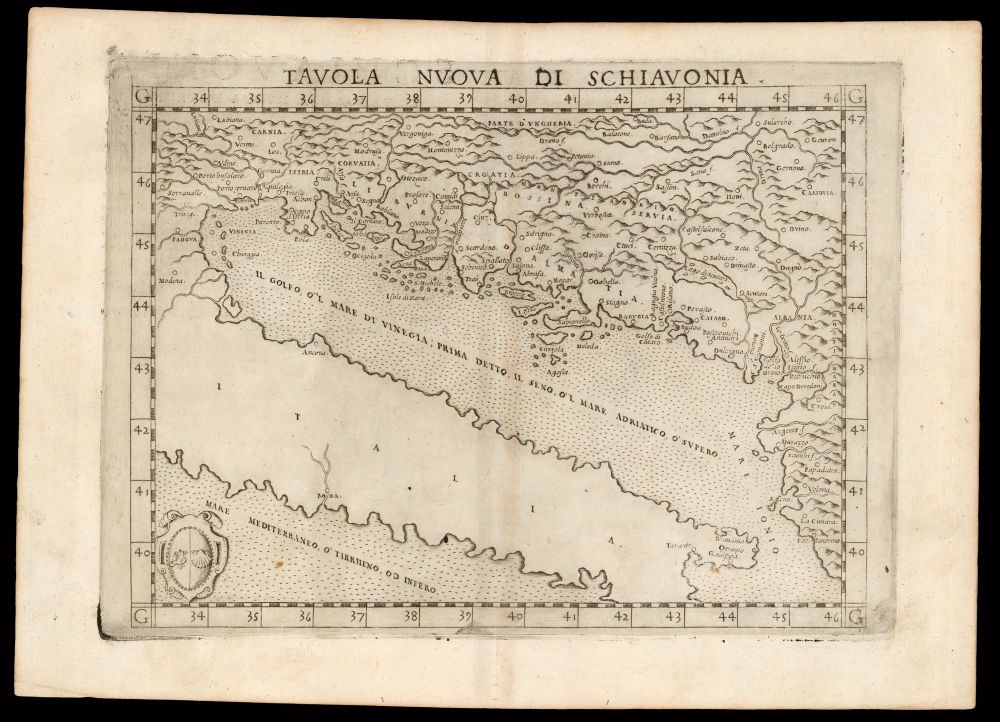1561 Ruscelli/ Gastaldi map of the Dalmatian Coast
Dalmatia-ruscelli-1574
Title
1574 (undated) 7.5 x 10.5 in (19.05 x 26.67 cm) 1 : 5600000
Description
A Closer Look
Coverage embraces the eastern Adriatic from the Danube River in the north to the Gulf of Venice and the Ionian Sea. It thus details from Padua in Italy, and the regions of Croatia, Bosnia, Serbia, Montenegro, and Albania. It follows the format of the Ptolemaic Quinta Europae Tabula in showing Italy in outline while detailing the Balkans, but follows Gastaldi's 1548 map in presenting contemporaneous geographical detail both in terms of topography and place names. Gastaldi's earlier work is the first modern depiction specifically of the Balkans: the present work, engraved in 1561, is a larger and more legible map - the product of the superior skill of Giulio Sanuto, who engraved most if not all of the maps for Ruscell's Ptolemy.Publication History and Census
This map was engraved for inclusion in the 1561 edition of Girolamo Ruscelli's Ptolemy. The maps for the 1561, 1562 and 1564 printings were printed two-to-a-plate, and examples of such maps exhibit platemarks running off the top of the page. At some point after 1564 the plate was divided, and the individual maps exhibit plate marks all the way around the printed image thereafter. This example conforms to the 1574 state of the map. The verso text and catch letters are identical on the right hand side, but the text to the left completing the section pertinent to the previous map (Flanders) is not present, implying the existence of a variant edition, or a printers' error.CartographerS
Giacomo Gastaldi (c. 1500 - October, 1566) was an Italian astronomer, cartographer, and engineer active in the second half of the 16th century. Gastaldi (sometimes referred to as Jacopo or Iacobo) began his career as an engineer, serving the Venetian Republic in that capacity until the fourth decade of the sixteenth century. During this time he traveled extensively, building a large library relating to voyages and exploration. From about 1544 he turned his attention to mapmaking, working extensively with Gextantiovanni Battista Ramusio, Nicolo Bascarini, and Giovanbattista Pedrezano, as well as taking private commissions for, among others, Venice's Council of Ten. He is credited with the fresco maps of Asia and Africa still extant in the map room of the Doge's Palace. Gastaldi was also one of the first cartographers to embrace copper plate over woodblock engraving, marking an important development in the history of cartography. His 1548 edition of Ptolemy's Geographia was the first to be printed in a vernacular; it was the first to be printed in copperplate. As with his Swiss/German contemporary Münster, Gastaldi's work contained many maps depicting newly discovered regions for the first time, including the first map to focus on the East Coast of North America, and the first modern map of the Indian Peninsula. His works provided the source for the vast majority of the Venetian and Roman map publishers of the 1560s and 70s, and would continue to provide an outsize influence on the early maps of Ortelius, De Jode, and Mercator. More by this mapmaker...
Girolamo Ruscelli (1500 - 1566) was an Italian polymath, humanist, editor, and cartographer active in Venice during the early 16th century. Born in Viterbo, Ruscelli lived in Aquileia, Padua, Rome and Naples before relocating to Venice, where he spent much of his life. Cartographically, Ruscelli is best known for his important revision of Ptolemy's Geographia, which was published posthumously in 1574. Ruscelli, basing his work on Gastaldi's 1548 expansion of Ptolemy, added some 37 new "Ptolemaic" maps to his Italian translation of the Geographia. Ruscelli is also listed as the editor to such important works as Boccaccio's Decameron, Petrarch's verse, Ariosto's Orlando Furioso, and various other works. In addition to his well-known cartographic work many scholars associate Ruscelli with Alexius Pedemontanus, author of the popular De' Secreti del R. D. Alessio Piemontese. This well-known work, or "Book of Secrets" was a compilation of scientific and quasi-scientific medical recipes, household advice, and technical commentary on a range of topics that included metallurgy, alchemy, dyeing, perfume making. Ruscelli, as Alexius, founded a "Academy of Secrets," a group of noblemen and humanists dedicated to unearthing "forbidden" scientific knowledge. This was the first known experimental scientific society and was later imitated by a number of other groups throughout Europe, including the Accademia dei Secreti of Naples. Learn More...
Source
- 1561 La Geographia di Claudio Tolomeo Alessandrino, Italian. Venice, Vincenzo Valgrisi.
- 1562 Geographia Cl. Ptolemaei Alexandrini, Latin. Venice, Vincenzo Valgrisi.
- 1564 La Geographia di Claudio Tolomeo Alessandrino, Italian. Venice, Giordano Ziletti.
- 1564 Geographia Cl. Ptolemaei Alexandrini, Latin. Venice, Giordano Ziletti.
- 1574 La Geographia di Claudio Tolomeo Alessandrino, Italian. Venice, Giordano Ziletti.
- 1598 Geographia di Claudio Tolomeo Alessandrino, Italian. Venice, heirs of Melchoir Sessa.
- 1599 Geographia di Claudio Tolomeo Alessandrino, Italian. Venice, heirs of Melchoir Sessa.

